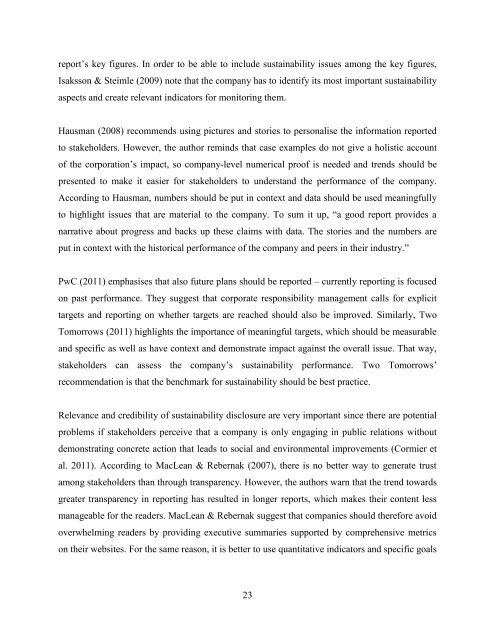Developing sustainability reporting - Case Cargotec - Aaltodoc
Developing sustainability reporting - Case Cargotec - Aaltodoc
Developing sustainability reporting - Case Cargotec - Aaltodoc
You also want an ePaper? Increase the reach of your titles
YUMPU automatically turns print PDFs into web optimized ePapers that Google loves.
eport’s key figures. In order to be able to include <strong>sustainability</strong> issues among the key figures,<br />
Isaksson & Steimle (2009) note that the company has to identify its most important <strong>sustainability</strong><br />
aspects and create relevant indicators for monitoring them.<br />
Hausman (2008) recommends using pictures and stories to personalise the information reported<br />
to stakeholders. However, the author reminds that case examples do not give a holistic account<br />
of the corporation’s impact, so company-level numerical proof is needed and trends should be<br />
presented to make it easier for stakeholders to understand the performance of the company.<br />
According to Hausman, numbers should be put in context and data should be used meaningfully<br />
to highlight issues that are material to the company. To sum it up, “a good report provides a<br />
narrative about progress and backs up these claims with data. The stories and the numbers are<br />
put in context with the historical performance of the company and peers in their industry.”<br />
PwC (2011) emphasises that also future plans should be reported – currently <strong>reporting</strong> is focused<br />
on past performance. They suggest that corporate responsibility management calls for explicit<br />
targets and <strong>reporting</strong> on whether targets are reached should also be improved. Similarly, Two<br />
Tomorrows (2011) highlights the importance of meaningful targets, which should be measurable<br />
and specific as well as have context and demonstrate impact against the overall issue. That way,<br />
stakeholders can assess the company’s <strong>sustainability</strong> performance. Two Tomorrows’<br />
recommendation is that the benchmark for <strong>sustainability</strong> should be best practice.<br />
Relevance and credibility of <strong>sustainability</strong> disclosure are very important since there are potential<br />
problems if stakeholders perceive that a company is only engaging in public relations without<br />
demonstrating concrete action that leads to social and environmental improvements (Cormier et<br />
al. 2011). According to MacLean & Rebernak (2007), there is no better way to generate trust<br />
among stakeholders than through transparency. However, the authors warn that the trend towards<br />
greater transparency in <strong>reporting</strong> has resulted in longer reports, which makes their content less<br />
manageable for the readers. MacLean & Rebernak suggest that companies should therefore avoid<br />
overwhelming readers by providing executive summaries supported by comprehensive metrics<br />
on their websites. For the same reason, it is better to use quantitative indicators and specific goals<br />
23
















